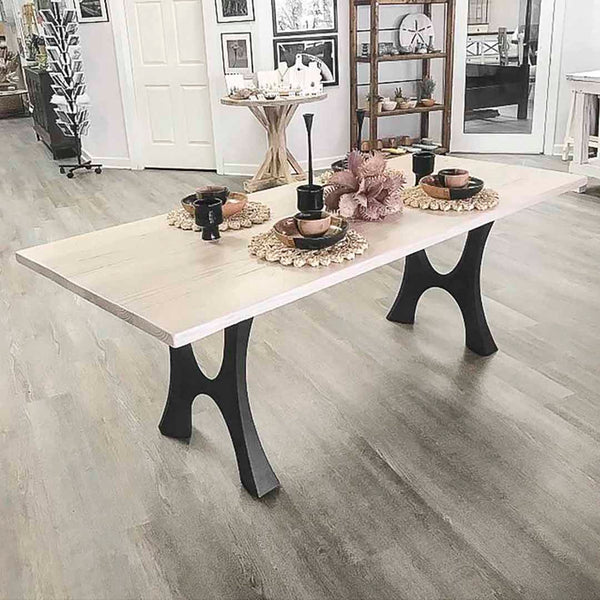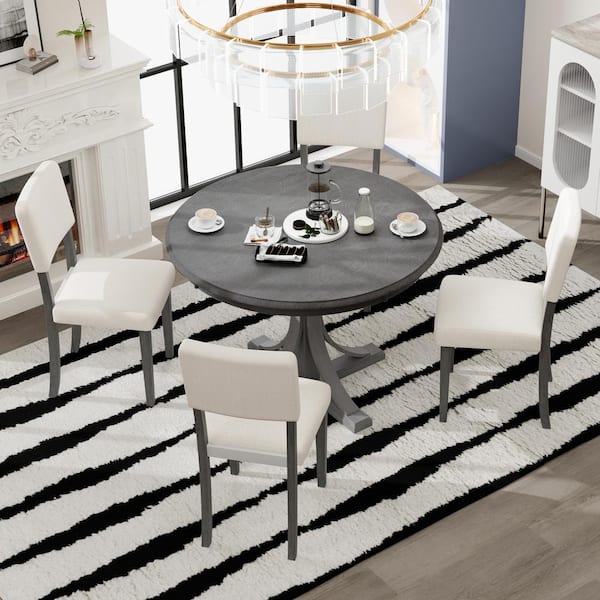How to Maintain and Care for Your Dining Room Table Legs
How to Maintain and Care for Your Dining Room Table Legs
Blog Article
Just How to Pick the Perfect Dining-room Table Legs for Your Home Décor
Choosing the excellent dining-room table legs is a nuanced process that requires cautious factor to consider of various aspects, including your space constraints, aesthetic choices, and functional demands. The interplay in between dimensions, products, and designs can significantly influence the ambiance of your eating location, making it necessary to approach this decision methodically. As you contemplate the myriad options available, it ends up being clear that the ideal option prolongs beyond mere appearance; it can enhance your general dining experience. What elements should you prioritize to guarantee your option complements your home's special character?
Assess Your Dining Area
Examining your dining room is vital for choosing the right table legs that complement both aesthetic appeals and performance. Begin by measuring the measurements of your dining location, including ceiling elevation, floor room, and distance to various other furniture. This details will assist identify the appropriate dimension and height of your table, which directly affects the option of table legs.
Following, take into consideration the style and design of your eating space. As an example, an open-concept design might profit from table legs that provide aesthetic agility, such as slim metal or acrylic choices. Conversely, a much more typical setting might require tough wooden legs that provide a sense of durability.
Assess the existing shade combination and materials in your dining area. Harmonizing the table legs with these components develops a natural appearance that boosts the general decoration.
Eventually, a complete assessment of your dining room will certainly assist you in making a notified decision, making certain that your table legs not just improve the visual appeal yet additionally serve functional functions.
Consider Your Style Preferences
When choosing dining-room table legs, it is vital to assess your personal style preferences, as they dramatically affect the overall visual of your eating space. Your selection of table legs can either complement or contrast with existing décor, making it essential to align them with your preferred indoor style theme.
If your home leans in the direction of a contemporary aesthetic, consider streamlined metal or minimalist wood legs that offer a tidy, clean appearance. For a much more standard approach, luxuriant wooden legs with detailed makings can add a touch of elegance and class. Industrial styles gain from robust, resources such as recovered wood and steel mixes, showing a sturdy appeal.
In addition, farmhouse and rustic styles frequently prefer sturdy, beefy legs that stimulate a sense of heat and comfort. Alternatively, if your decoration is diverse, you might select unusual shapes or a mix of products to create aesthetic interest.

Evaluate Product Options
The selection of material for dining space table legs plays a crucial role in both sturdiness and visual allure. Usual materials include wood, metal, and composite choices, each offering distinctive features that can affect the overall look and durability of your table.
Wood is a traditional option, recognized for its heat and convenience. Woods like oak and walnut provide outstanding stamina and can be ended up in various stains to match any design. However, softwoods like pine are extra prone to scratches and dents, making them less optimal for high-traffic areas.
Metal legs, commonly crafted from steel or light weight aluminum, exude modernity and industrial charm. They are extremely resilient and immune to wear, making them suitable for family members with youngsters or regular events (dining room table legs). Additionally, steel can be ended up in different you can try here colors, enhancing the customization opportunities
Composite products, such as MDF or laminate, offer price and varied designs. While typically much less long lasting than solid timber or metal, they can still provide a fashionable look and are typically simple to maintain.
Inevitably, the material you pick must align with your way of living, visual choices, and the degree of use your dining table will certainly experience.
Determine Height and Dimension
Selecting the suitable height and dimension for your dining space table is important for both capability and comfort. The standard elevation for dining tables commonly ranges from 28 to 30 inches, enabling ample legroom for a lot of individuals when seated. Nevertheless, it is crucial to think about the measurements of your dining area and the kinds of chairs you plan to utilize.

Additionally, think about the percentages of your visit site dining space. A larger table in a sizable location can develop a grand atmosphere, while a smaller table functions well in more intimate settings. Ultimately, the best height and size will balance with your general design and improve the eating experience for you and your guests.
Explore Customization Possibilities

Additionally, the layout of the legs can be personalized to fit various designs, such as rustic, contemporary, or industrial. As an example, conical legs can evoke a mid-century modern-day feel, while beefy, block-style legs might resonate with traditional or farmhouse style.
Property owners can also discover color coatings, from natural timber stains to repaint, enabling them to match see here now or comparison with the table top and bordering decoration.
Additionally, leg height can be gotten used to accommodate details seating plans or individual preferences, boosting both convenience and functionality.
Finally, unique embellishments, such as makings or decorative braces, can further customize the table legs, making the dining experience not simply a dish however a declaration item in the home. By thinking about these modification options, house owners can create a dining-room table that truly shows their originality.
Verdict
Selecting the suitable dining-room table legs needs cautious factor to consider of various elements, consisting of the dimensions of the dining room, design preferences, material longevity, and desired height. Personalization choices better enhance the capability to accomplish a natural visual that enhances the total decor. By systematically assessing these aspects, house owners can guarantee that the picked table legs not just fulfill functional requirements but also contribute positively to the dining experience and atmosphere of the home.
Choosing the excellent eating area table legs is a nuanced procedure that calls for mindful factor to consider of numerous aspects, including your space constraints, aesthetic preferences, and practical needs.Analyzing your eating room is critical for picking the right table legs that enhance both visual appeals and performance.When identifying size, gauge the location where the table will be placed to ensure it fits pleasantly, permitting for at least 36 inches of clearance around the table for easy activity. A bigger table in a roomy location can develop a grand atmosphere, while a smaller table functions well in even more intimate settings.Picking the suitable dining room table legs calls for cautious consideration of numerous aspects, including the measurements of the eating room, style preferences, product sturdiness, and desired elevation.
Report this page